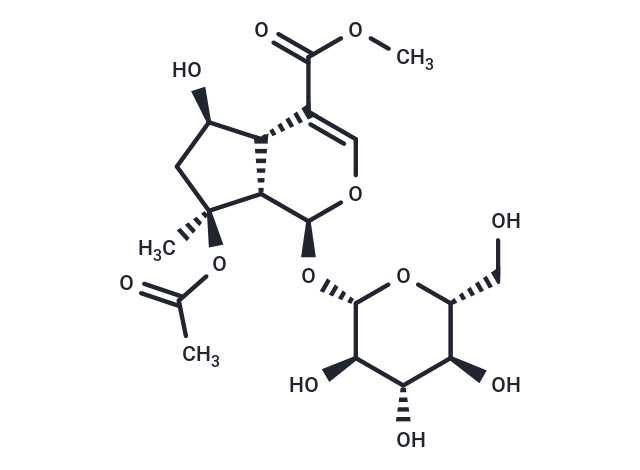- Remove All
 Your shopping cart is currently empty
Your shopping cart is currently empty
Barlerin
Barlerin (8-O-Acetylshanzhiside methyl ester) has potential against cerebral ischemic injury, and its protective effect on oxygen-glucose deprivation-induced injury might be due to the suppression of intracellular Ca2+ elevation and caspase-3 activity, and improvement of mitochondrial energy metabolism.8-O-Acetylshanzhiside methylester can increase angiogenesis and improve functional recovery after stroke.8-O-Acetylshanzhiside methylester has protective effects on experimental myocardial ischemia injury, the effects might be due to block of myocardial inflammatory cascades through an HMGB1-dependent NF-κB signaling pathway.8-O-Acetylshanzhiside methylester protects diabetic brain against I/R injury by alleviating diabetic cerebral I/R injury and attenuating blood–brain barrier (BBB) breakdown, and its protective effects may involve HMGB-1 and NF-κB signalling pathway.

Barlerin
| Pack Size | Price | Availability | Quantity |
|---|---|---|---|
| 1 mg | $34 | In Stock | |
| 2 mg | $48 | In Stock | |
| 5 mg | $77 | In Stock | |
| 10 mg | $117 | In Stock | |
| 25 mg | $257 | In Stock | |
| 50 mg | $373 | In Stock | |
| 100 mg | $562 | In Stock | |
| 1 mL x 10 mM (in DMSO) | $84 | In Stock |
Product Introduction
| Description | Barlerin (8-O-Acetylshanzhiside methyl ester) has potential against cerebral ischemic injury, and its protective effect on oxygen-glucose deprivation-induced injury might be due to the suppression of intracellular Ca2+ elevation and caspase-3 activity, and improvement of mitochondrial energy metabolism.8-O-Acetylshanzhiside methylester can increase angiogenesis and improve functional recovery after stroke.8-O-Acetylshanzhiside methylester has protective effects on experimental myocardial ischemia injury, the effects might be due to block of myocardial inflammatory cascades through an HMGB1-dependent NF-κB signaling pathway.8-O-Acetylshanzhiside methylester protects diabetic brain against I/R injury by alleviating diabetic cerebral I/R injury and attenuating blood–brain barrier (BBB) breakdown, and its protective effects may involve HMGB-1 and NF-κB signalling pathway. |
| Alias | ND01, 8-O-Acetylshanzhiside methyl ester |
| Molecular Weight | 448.42 |
| Formula | C19H28O12 |
| Cas No. | 57420-46-9 |
| Smiles | COC(=O)C1=CO[C@@H](O[C@@H]2O[C@H](CO)[C@@H](O)[C@H](O)[C@H]2O)[C@H]2[C@@H]1[C@H](O)C[C@]2(C)OC(C)=O |
| Relative Density. | 1.52 g/cm3 |
| Storage | Powder: -20°C for 3 years | In solvent: -80°C for 1 year | Shipping with blue ice. | |||||||||||||||||||||||||||||||||||
| Solubility Information | DMSO: 82 mg/mL (182.86 mM), Sonication is recommended. | |||||||||||||||||||||||||||||||||||
Solution Preparation Table | ||||||||||||||||||||||||||||||||||||
DMSO
| ||||||||||||||||||||||||||||||||||||
Sci Citations
Calculator
In Vivo Formulation Calculator (Clear solution)
Dose Conversion
Tech Support
Keywords

Copyright © 2015-2025 TargetMol Chemicals Inc. All Rights Reserved.



